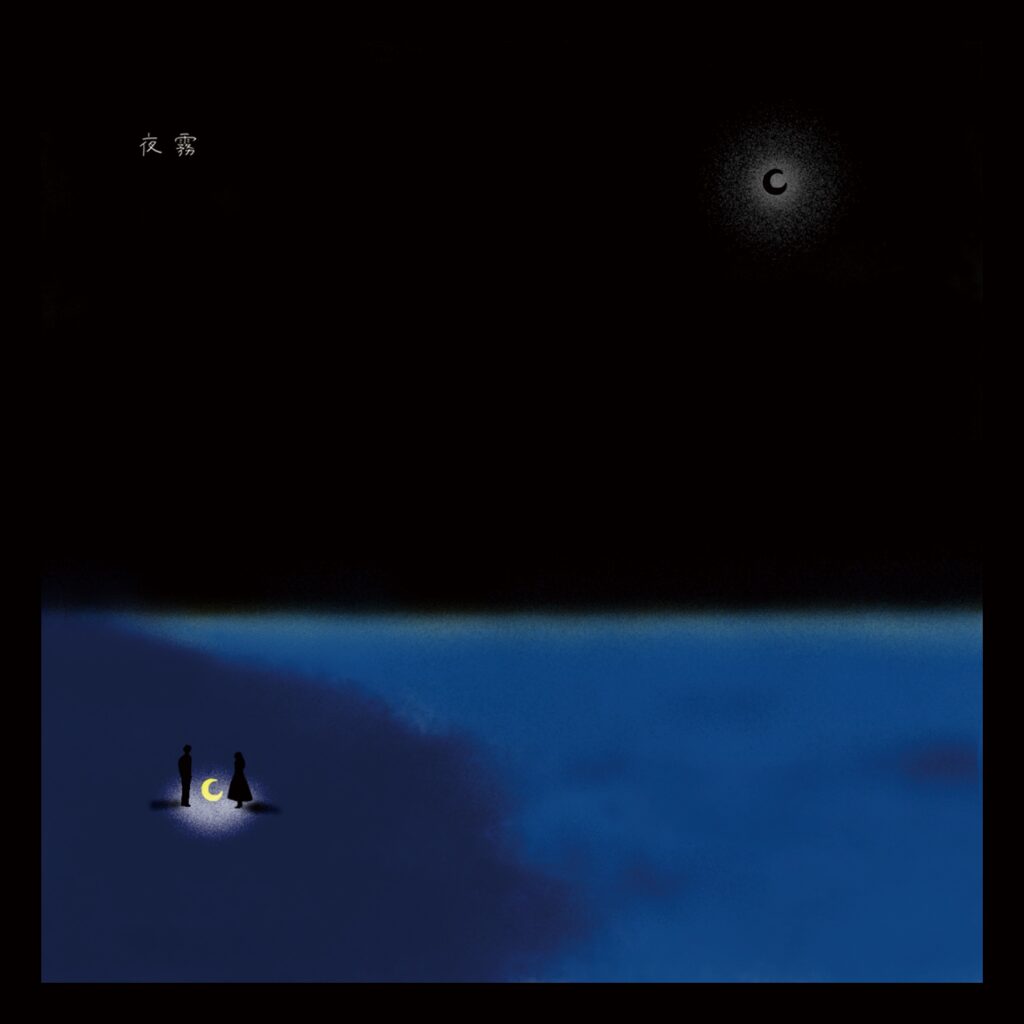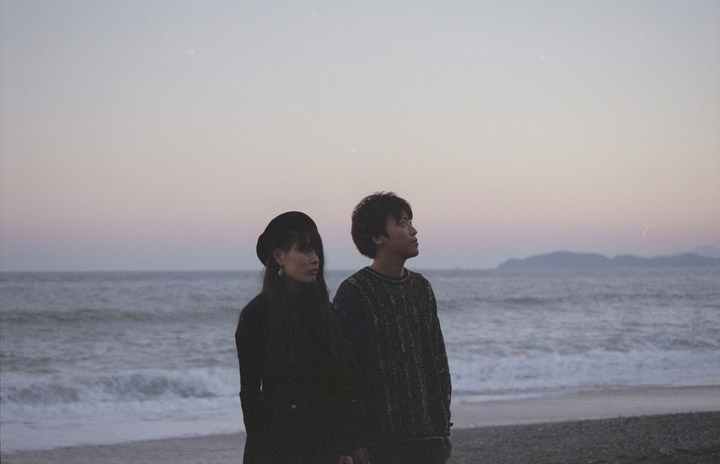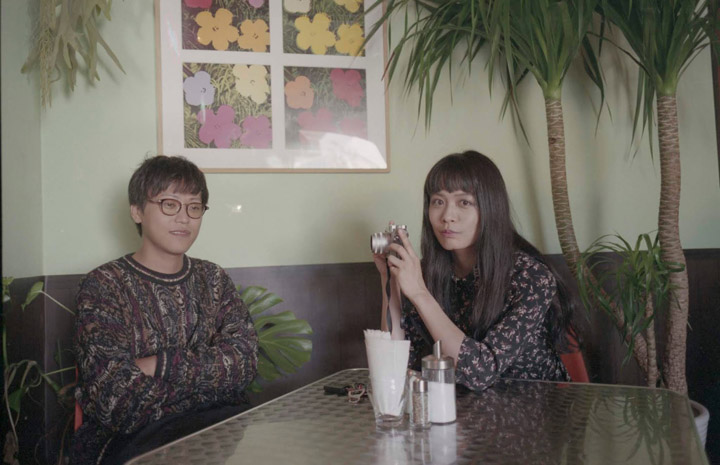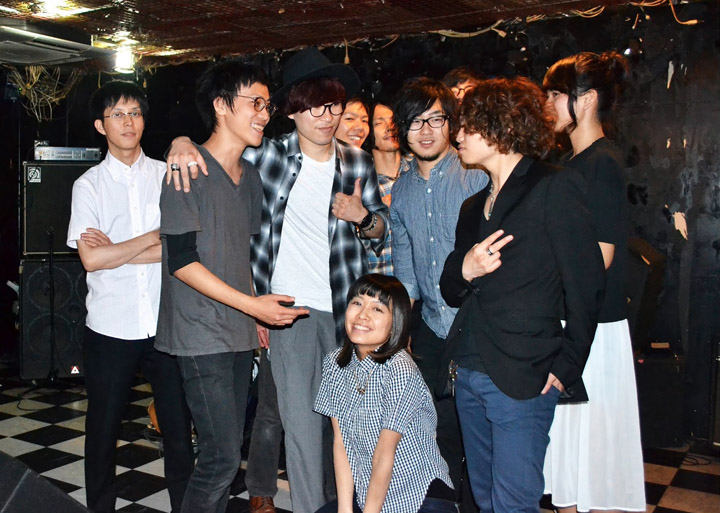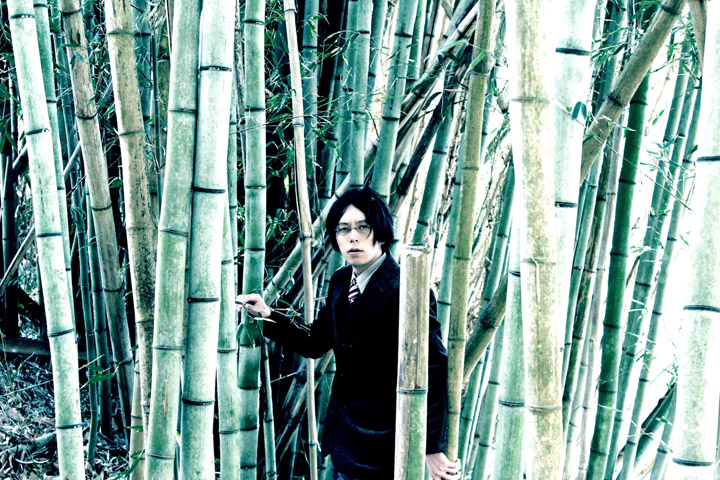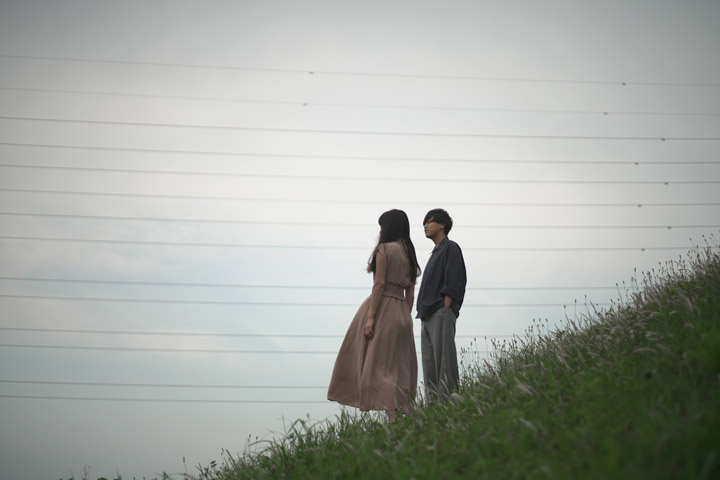To commemorate Uwanosora’s awesome third album, Yogiri, finally being made available on Spotify last month, here is an interview about it. You owe it to yourself to give it a listen. Enjoy!
Interview & text: Uchi Takahide of WebVANDA (Japanese text: part one & part two)
English translation: Henkka
Uwanosora on the web: Website, Instagram, Kadoya Hirohide Twitter, Iemoto Megumi Twitter
Note: You can buy Yogiri from CDJapan.
With the release of their second album Hidamari in 2017 (and a subsequent analog pressing the following year) still fresh in our minds, Uwanosora are releasing their eagerly anticipated third album Yogiri on June 26th.
This being their second release after becoming a duo in August 2017, Kadoya Hirohide (guitar, songwriting, production) and Iemoto Megumi (vocals) have, since the city pop beginnings of their 2014 debut, incorporated elements of various other genres into their music as they continue to develop their sound. One might even say they have become “music for the discerning music fan.”
In this interview, we asked the two members about the creation process of this album.
— Congratulations on the release of your third album! From what I understand, it was originally meant to be released as a double album alongside Hidamari. Why was that the initial plan for these releases, and why did you end up splitting them up?
Kadoya Hirohide: Thank you. I had a bunch of songs I’d written in my student years that I had been wanting to release for the longest time. Since there were so many songs, we divided them into two groups based on the time of day in the lyrics. The reason it became two separate albums — Hidamari (Sunny Spot) and Yogiri (Night Fog) — was simply because we didn’t have the budget to be able to record all songs in one go.
— Ah, I see. That was a great idea splitting them up based on the time of day. I’m curious: how big is your stock of songs that you wrote in your student days?
Kadoya: I pretty much exhausted the whole stock with Uwanosora ’67, Hidamari, and Yogiri. I’m finally no longer bound by ideas I first had as a student.
— Compared to your previous releases, this one has a strong feel of 70s new soul, blue-eyed soul, and AOR. Was this a conscious decision made when you were thinking about the concept and the album as a whole?
Kadoya: We had the vague “night fog” concept, and I feel like the album did end up having that sort of an atmosphere to it. But it’s different from AOR (especially 80s AOR) — if I had to call it something, I suppose I might call it “pre-AOR.” Hearing it now that it’s finished, I feel like there’s also something “warped” about it for it to be either new soul or blue-eyed soul. Something about it that’s not quite of the past or the present; that for better or worse sounds like Uwanosora.
— When you say “warped,” do you maybe mean something like a uniquely Japanese interpretation of those genres? A different feel than the original thing?
Kadoya: Well, naturally the performances themselves are different. But also, in the 70s and 80s, music like that was mainstream culture — people were doing those genres because it would sell. We don’t have that sort of capitalistic motive or ideology for making music. And obviously because the recording environments are totally different, so it is then with the sound. Finally, we don’t really cross paths with today’s pop culture. We’re sort of detached from it, only describing ourselves as “pop” because we don’t have anything better to call ourselves.
So in terms of our mindset, our sound, our ideals… Everything about us is a bit “warped” in comparison. But then we can only express exactly what it is that we want to express, because otherwise it would feel meaningless. Oh, well…
— You mentioned that some of these songs were written even prior to your first album, back when you were still a student. Please give us some anecdotes in regards to the songwriting process.
“Sweet Serenade”
Kadoya: I wrote this song in the spring of my second year of college. I fell sick and had to be hospitalized for about a month, up on floor ten-something of Waseda’s International Medicinal Center. My friends were all having fun making movies and stuff in Osaka while I had to remain in Tokyo, unable to do anything. That’s what was so vexing about it — not being able to create.
However, the night view from that hospital room was so remarkably beautiful… Feeling inspired by it, at night I would set my tiny second-hand MIDI keyboard on the small table used for hospital meals, and I’d be working on melodies with an IV drip dangling from my arm. The demo had a snare hit on the second and fourth beats, but one of the changes I later made was to only have it on the second beat.
— Last July we were at a certain get-together where you played us a rough mix of this song, and already at that stage its degree of perfection made it hard for me to believe you had written it when you were only a sophomore. One listen was enough for me to realize how the song is paying homage to the Leon Ware-produced “I Want You” by Marvin Gaye. But one simply can’t achieve this sort of groove unless your expressiveness and performing chops are up to par. Surely you must have struggled with the recording of this one?
Kadoya: Not that much, no. We had 90% of it down at the pre-production stage. We did have to make the rhythm section very simple though because there’s so much stuff on the top end, but then my impression is that it made the song sound cleaner as a result.
We actually filmed a music video for this song in 2015, and we screened it for people just once when we were invited to a South Korean film festival in 2016. I feel bad for the director for us not being able to make the music video public.
“Roxy ni Tsuite”
Kadoya: This is a song I wrote in 2014 before the release of our first album.
I love Steely Dan, and I remember writing this song purely out of my love for them. In my mind, Steely Dan is the perfect accompaniment specifically to the bar scene of Tsuruhashi — nothing beats the feeling of listening to some Steely Dan after having had drinks there. We also played this song at our 2015 show.
Back when I was living in Izu, Fukuda from Blue Peppers came over and I played this song to him. The whole time he was grinning to himself and going, “Doctor Wu! Doctor Wu!” Fukuda himself has also written songs with a clear Steely Dan influence, so I started to think, “I wonder what sort of harmonies Fukuda would write for this song…?” And so last year I asked him to re-harmonize the song, and earlier this year I got him to sing backing vocals on it, too.
The sax solo was taken directly from the 2014 demo. As we finished recording it, Ochi, the drummer, sort of absentmindedly said, “I’m pretty sure no one in the world practiced the Purdie Shuffle more than I did this past year…”
— Listening to the mastered song it’s great to hear the Steely Dan-ness. But while the intro is all “Doctor Wu” (from the album Katy Lied, 1975), the rest is an homage to “Home At Last” (from the album Aja, 1977). As your drummer commented, it’s Bernard Purdie playing on the song, and he even went on to demand a songwriting credit for his contribution to it. (laughs) But it was your idea for the song to have that heavy shuffle rhythm ever since you first made the arrangement, right?
Kadoya: Arrangement-wise, yes. It’s just as I originally wanted it. I don’t think we’ll be doing this kind of thing again though.
“Yogiri no Koibitotachi -Interlude-“
Kadoya: There are quite a few modulations in this one. The key keeps constantly sort of adrift, never settling down.
From the winter of 2018 to February 2019, me and Fukamachi — the backing vocal and string arranger — spent two months living together, arranging and recording. I had felt that me and him were pretty similar in musical terms… But as we got to recording the backing vocals he went so far as to saying, “If you ever bring me another song like this I’m not going to be doing the backing vocals for it.” Due to the key constantly changing, the backing vocals are super difficult even with the score in front of you. But that harmony was nevertheless something I really wanted to express, so… While I felt bad for him, I do think we got something great as a result. Yokoyama on sax gave us some great playing on it, too.
Someya from Lamp is the person who first gave me the idea for this song. He sent me this list of tracks, going, “Here, a selection of a bunch of songs that will change your life. (^^♪” One of the artists included, Nivaldo Ornelas, left a deep impression on me. I bought his albums straight away and found a bunch of other songs of his that moved me as well, which is where I got the idea.
— While the song is only a little over three minutes long, all those difficult chord progressions sure are memorable. It must have been extremely difficult to have the backing vocals flow as well as they do with those key changes. Nivaldo Ornelas, your inspiration for the song, is also known as a member of Hermeto Pascoal’s band and as a Minas music saxist. I’ve heard his playing on the mid-70s records of Edu Lobo and Egberto Gismonti, as well as on Toninho Horta’s second album, but I’ve never actually heard his solo material. Could you recommend us an album by him?
Kadoya: A tarde and Viagem atraves de um sonho — I got them as a two-in-one collection.
“Inseki no Love Song”
Kadoya: To me, this one along with “Chou no Tattoo” and “Marvin Kakete” feel like the “new songs” as I only wrote them last year.
I like the sort of science fiction-y stuff such as “Picnic wa Arashi no Naka de” (from the album Uwanosora, 2014), and I wrote this song with the intention of it having that same kind of ambiance to it. I like the contrast between the happy-sounding composition and the sad lyrics. For this one, I got the inspiration from the sort of counterpoint used by filmmakers like Kurosawa Akira.
Moving back to Tokyo the year before last and working here, I kept meeting people that I just couldn’t seem to get along with. I was trying to convince myself how that was just a part of what “work” entailed, but at the same time I was having lots of conflicting thoughts, too… Something as trivial as that was what made me start noticing other things. How we all keep hurting one another in this current internet society. All the tragic news that just keep coming every single day. The never-ending wars. No one knows what to do about any of that — you’re just supposed to accept it.
But then I thought, “What if a meteorite fell on Earth?” Even if it was only for an instant and only within the world of my lyrics, I wanted to create a passing moment when all of humanity was at peace, watching the approaching meteorite.
However, when it came to making the music video, Sugano, the director, said something to me. “If there was really a meteorite about to hit Earth, the only people capable of taking it so lightly would be the ones with some substantial emotional leeway in their hearts. But otherwise? There would be something much uglier happening.” His words really startled me. He was right — the world isn’t that innocent. Him saying that made me realize how much more mature he is compared to me; how he genuinely observes our world.
— That story of how you wrote the lyrics is very interesting indeed. The first time I heard the rough mix of this album, this song was always the one I was taken with the most. “Yohou doori chikyuu ni shoutotsu suru / ikimono wa minna kieteshimau rashii” (“It’s going to make impact with Earth as predicted / apparently all living things will cease to be“) — that first line, both shocking and surreal, contrasted with the sweetness of the melody… It’s just indescribable. I remember feeling the same way when I first heard “Picnic wa Arashi no Naka de.” You’ve always liked this kind of style, haven’t you?
Kadoya: I have several friends who love these types of lyrics. They don’t care about other kinds of lyrics that are similarly gloomy, or ones that tell the story of two people or whatever — it’s only that science fiction element which can hold their attention. Those friends might have been one of my motivations.
Like “Picnic wa Arashi no Naka de,” for me this song initially lacked impact. But as time went on I found myself listening to it more and more. There’s just something I like about lyrics like that. There’s an air of disinterest, both in the protagonists of the lyrics as well as in my compositions. Although I feel like that kind of feeling might be a common thing with people of my generation.
But then on the other hand, stuff like the bubbliness of “Futari no Natsu Monogatari” or Matsutoya Yumi or Matsumoto Takashi, or catchphrases from TV commercials like the Olympus OM10 “instead of saying I love you, I pressed the shutter“ — that kind of thing never fails to make my heart beat faster. I’ve always loved stuff like that. But sadly I personally know hardly anyone either my own age or anyone older who gets that kind of thing besides me. I’m taking applications for new friends…
— Please list five songs each that you would listen to as you were creating an image for this album.
Kadoya Hirohide
○ “I Want You” / Marvin Gaye
○ “Do What Comes Natural” / Gene Chandler
○ “Jenny My Love” / Inoue Yosui
○ “Kore wa Koi de wa nai” / Pizzicato Five
○ “Quiet Storm” / Smokey Robinson
Iemoto Megumi
○ “Wish Upon A Star” / Franne Golde
○ “Lord We Believe” / Kristle Murden
○ “Here We Go” / Minnie Riperton
○ “Blush” / Mr Twin Sister
○ “Kage ni Natte” / Matsutoya Yumi
— How long did the album take to record? Also, please introduce along with some anecdotes the musicians who took part in the recording of this album.
Kadoya: The recordings took place from September 2018 to the end of March 2019. We’ll tell you about all the musicians who were involved, together with some stories.
(Personnel introductions by Kadoya Hirohide & Iemoto Megumi.)
Fukamachi Takashi
He’s been helping with the backing vocal and string arrangements ever since the first album. When we were living together I was usually the one making dinner, and since I’d usually cook large quantities I managed to fatten him up quite nicely. I remember this one time eating a cup of Umakacchan instant ramen that he’d bought for himself — it’s kind of like his soul food — and he just had this immensely sorrowful expression on his face.
Kumashiro Takato
He’s been playing bass for us since the first album. He is in great demand as a player around the Kansai region. I was working by myself on New Year’s Eve, and right after the New Year had started he drove over to give me what was his idea of toshikoshi soba: a box of Peyang GIGA MAX instant yakisoba noodles. He’ll only slap his bass maybe three times a year.
Tamada Kazuhei
He does percussion and engineering for us. I bought some bongos and wanted him to play them, so I got him to help with that from New Year’s Day. We spent about two months mixing the album, corresponding almost daily by phone and email, usually from midnight until six in the morning. He helped with even the tiniest of details so I’m enormously grateful to him. He told me that despite having recorded over 1000 bands, Hidamari and Yogiri were easily in his “top three most difficult projects” he’d ever worked on.
Ochi Yusuke
He played drums on a few songs on the first album, and on this album I got him to play on all of them. He’s a busy supporting player for lots of artists, including Kusunose Seishiro’s band. He lives in Tokyo so he had to come a long way to record for us in Osaka, but he really gave us some amazing performances.
Sugiyama Satoshi
He did nearly all of the keyboard parts on this album. I see him as the no. 1 greatest young player in Kansai. He’s so passionate. Even as our recording session dragged on into the late hours of the night, he just kept on giving one amazing performance after another. After we were done recording, he said, “You sending me that huge pile of materials and sheet music already told me I was going to have my work cut out for me.” (laughs)
Miyawaki Shohei
He’s been playing keyboards for us since the first album. He currently works in Tokyo as a supporting musician — including on Kosaka Chu’s albums — and keeps busy with his own projects. On this album he only plays on one song, but I would also often turn to him for songwriting advice and that sort of thing.
Nanba Daisuke
He was my junior in college. He’s a guitarist, currently working mainly as an instructor and performer. Ever since college I was always taken with his guitar lines and masterful sense of time. I’ll always turn to him if I need any help. “Hotel 70” features as-is the solo that he originally recorded for the demo at the age of 22.
Yokoyama Takao
Beginning with ’67, I’ve always turned to Yokoyama for saxophone and flute solos. His playing always moves me. He’s a leading figure in the Kansai scene as a performer and recording musician, having played just about everywhere, even for like NHK and such. The musicians around me all call him “God.”
Even personality-wise I respect everything about him. As we were recording this album, I asked him during a break if he’d ever thought about quitting music. He said, “Sure, all the time!” Knowing how even someone as amazing as him has thoughts like that, there was a feeling of kinship and even a kind of relief. As we were talking about performing, he said things like… “I want to play in a way that makes people who are facing away turn around and see what’s up.” “There are things one can learn from all music. I’m still learning myself.” All these sorts of things that really made me think. It might all be something obvious, but to me he is like a mentor who tells me all kinds of truths I need to know.
And despite all that, he’s also the sort of friendly, humble person who’ll say things like, “I’ll play you anything you want for a beer.” He is just a class act through and through — if he wasn’t, there’s no way he would’ve agreed to play for some completely no-name act like “Uwanosora ’67” when we weren’t even sure if we’d be able to pay him a performance fee.
Uwanosora is a band that is able to express what we want to express thanks to the sheer love of music of people like him. A true hidden gem of a person. To me, he is my senior in life, and a living embodiment of that old proverb: “the more learned, the more humble.”
Sugino Motoki
He’s a sax player active in the Kansai region. I’m sometimes still told that the solo he played on “Roxy ni Tsuite” at the 2015 Uwanosora show was the “highlight of his life.” (laughs) I really do love his solos, even if we didn’t record one from him for this album. He’s going to be a supporting musician at our August show this year, so do look forward to hearing his soloing there.
Yokoo Shojiro
He must surely be the no. 1 young trumpet player in Kansai. Aside from performing and doing his own projects, he also won this year’s Naniwa Jazz Grand Prize, so he’s very active indeed. On the recording side of things, I was very impressed by how the brass section got together prior to recording just to practice by themselves. You can hear a cool solo by Yokoo on “Pearl Bridge wo Watattara” (from the album Hidamari, 2017).
His big band, YOKOO BB, have a YouTube channel. He’s also doing something pretty interesting later this year: he’s aiming for a Guinness World Record by conducting a big band that will have between 250 to 500 players. If it happens to take place in Kansai, I’m definitely going to go see it.
Isono Nobuki
Trombone player, and the youngest supporting musician on the album. The brass section rehearsals took place at his home studio of all places. There’s quite a lot of high notes in the songs, and he did a superb job with all of them. He was featured on Hidamari as well. I haven’t gotten to go see him live yet, so I’d love to be able to do so.
Fukujin Haruka
Horn player who was my junior in college but who I only got to know after I’d graduated. Once I did, I asked him to play on Hidamari. He currently lives in Wakayama, but he came over to Osaka just to play on one song. He says he gets more nervous in the studio rather than playing live, so he’d be constantly stretching when we were in recording. He helped us get exactly the sound I’d envisioned on the trombone/horn unison section in “Chou no Tattoo.”
Matsumoto Naoko
This was her first appearance on a release of ours. She’s a violinist active in Osaka who’s won a bunch of awards, and she had zero trouble playing any of the difficult sheet music we put in front of her. Watching her with her beautiful looks making all those great sounds with her violin, I felt nervous, dizzy, and excited all at the same time.
Nakatsuka Satoshi
He’s a senior of mine who’s been playing viola on all our albums since our first. We continue to rely on him. Having sworn a lifelong commitment to music and his cats to which he gives all his love, he also plays in his own Russian folk music-based band. He’s an instructor, too.
He was supposed to attend a jam session right after we were done recording, and he liked this one phrase in “Inseki no Love Song” so much that he said he was going to be using that phrase in his solos the whole day. Later I asked him about it, and it seems he had indeed kept soloing that phrase in perpetuity. (laughs) He’s also notable in my mind for having an extremely filthy car.
Tamaki Shunta
Our cellist since Hidamari. He currently plays in the Kansai Philharmonic Orchestra. Most of the time he’s just thinking about futsal and soccer — when we’re commuting together I’m always impressed to see how deep he gets into his soccer game. His great sense of pitch is always a great help.
Fukuda Naoki
The AOR Love Evangelist. He keeps busy as a member of Blue Peppers and as a radio DJ. He sang backing vocals and did the re-harmonization on “Roxy ni Tsuite.” He only wrote down the backing vocal melody during recording, and we still managed to finish in less than an hour. Once we were done it was straight back to recommending songs to each other. We had a blast.
Oketa Tomomichi
Former member of Uwanosora, presently a solo artist making albums and writing songs under the banner of “electronic kayou from an isolated island.” He composed “Yoru no Hakuchou” for this album. He originally wrote it back in 2015 for Yogiri, and we were just finally able to record it. The unique melody line and worldview of the lyrics is once again something that only Oketa could have created.
Utsunomia Yasushi
He has been active as a musician and music producer since the 1970s. With each new project he comes up with a musical theory unique to it and develops a sound system fitting for that specific musical expression. He’s known as the “wizard of acoustics,” and he’s been our mastering advisor since Uwanosora ’67. Every time I see him he presents me with new things to ponder on, and every time he makes me realize just how much more I have yet to learn.
Kadoya: I’m always deeply grateful to all of the participating musicians. Even just one sound produced by someone who has dedicated years or even decades to thinking about music, their instrument, and performing will have immense weight behind it. The fact that their combined sounds have resulted in this work is truly an honor for me. (Of course, with that said, I also love home recordings and I’m by no means rejecting that sound either. It’s something I’d like to try doing myself at some point.)
”Thank you very much. I hope to work with you again if we get the chance.” I always tell that to all the musicians as I bid them farewell. But every time I do, deep down I’m thinking to myself, “This could end up being the last time we ever work together.” Because it’s not like we have someone backing us with a huge budget or anything. We’re not even on an indie label — Uwanosora is an independent production all the way through. So, I don’t know… I guess I just get kind of sentimental at times like that.
— One can really sense your deep sense of gratitude to all of the musicians. Please do keep making creative sounds with all of these people.
Kadoya: There’s still so much more we want to express, so me and Iemoto will keep going at it for as long as we possibly can! Thank you for your support.
(Note: a brief promo about a 2019 concert is omitted here.)
— In closing, please give us your sales pitch for Yogiri.
Kadoya: 2:00 A.M. Suburbs near the countryside. Mere inches from the surface of the asphalt, you catch a fleeting glance of the faintly glistening night fog…
That’s the sort of feeling enclosed within this album. But as to what might be its appeal, that’s all up to the listener. Some people may like it, others won’t. It might be one of those albums that, if you don’t try it before you buy it, you might end up regretting it. Or maybe you’ll like it.
Iemoto: “Night” is the running theme throughout this album. There’s motifs in there like sexiness and purity and so on — that is to say, various different facets of “night” for one to discover.
I’m glad everyone can finally get to hear these songs, some of which had been written a number of years ago. It’s a different kind of album compared to our past works, so please do give it a listen.
